
Real Exam Questions and Answers as experienced in Test Center
300-535 Braindumps with 100% Guaranteed Actual Questions | https:alphernet.com.au
300-535 approach - Automating Cisco Service Provider Solutions (SPAUTO) Updated: 2024 | ||||||||
| Utilized these 300-535 dumps questions to get 100% marks | ||||||||
 |
||||||||
|
||||||||
|
Exam Code: 300-535 Automating Cisco Service Provider Solutions (SPAUTO) approach January 2024 by Killexams.com team | ||||||||
300-535 Automating Cisco Service Provider Solutions (SPAUTO) Test Detail: The Cisco 300-535 exam, also known as "Automating Cisco Service Provider Solutions (SPAUTO)," is a certification exam that validates the knowledge and skills of professionals in automating Cisco service provider solutions. The exam focuses on various aspects of network automation, programmability, and orchestration in the context of Cisco service provider environments. This description provides an overview of the 300-535 exam. Course Outline: The course for the Cisco 300-535 exam covers a wide range of syllabus related to automating Cisco service provider solutions. The course outline may include the following: 1. Introduction to Network Automation and Programmability: - Understanding the fundamentals of network automation - Exploring network programmability concepts and tools - Introduction to Cisco service provider solutions 2. Cisco Network Automation Framework: - Overview of Cisco network automation architecture - Understanding the components of Cisco Network Services Orchestrator (NSO) - Exploring Cisco Network Services Orchestrator (NSO) architecture and features 3. Network Automation Tools and Technologies: - Understanding YANG data models and NETCONF protocol - Exploring REST APIs and JSON/XML data formats - Introduction to model-driven telemetry and gRPC 4. Automating Service Provider Network Operations: - Automating network device configuration and provisioning - Implementing network service orchestration - Understanding service assurance and network troubleshooting automation 5. Network Automation using Cisco NSO: - Configuring and managing network devices using Cisco NSO - Service modeling and template-driven deployments with Cisco NSO - Advanced syllabus in Cisco NSO, such as service chaining and device synchronization Exam Objectives: The 300-535 exam objectives cover the following areas: 1. Network Automation and Programmability Fundamentals 2. Cisco Network Automation Framework 3. Network Automation Tools and Technologies 4. Automating Service Provider Network Operations 5. Network Automation using Cisco NSO Exam Syllabus: The exam syllabus for the 300-535 exam includes specific syllabus within each of the exam objectives mentioned above. It may cover areas such as: - Understanding network automation concepts, tools, and technologies - Exploring Cisco network automation frameworks and architectures - Configuring and managing network devices using Cisco NSO - Implementing service orchestration and automation in service provider environments - Leveraging REST APIs, YANG models, and other programmability technologies - Implementing model-driven telemetry and gRPC for network monitoring and analytics | ||||||||
| Automating Cisco Service Provider Solutions (SPAUTO) Cisco Automating approach | ||||||||
Other Cisco exams010-151 Cisco Certified Technician (CCT) for Data Center500-275 Securing Cisco Networks with Sourcefire FireAMP Endpoints CICSP Cisco IronPort Certified Security Professional 600-455 Deploying Cisco Unified Contact Center Enterprise (DUCCE) 500-210 SP Optical Technology Field Engineer Representative 500-052 Deploying Cisco Unified Contact Center Express (UCCXD) 500-651 Security Architecture for Systems Engineer (SASE) 500-701 Cisco Video Infrastructure Design (VID) 500-301 Cisco Cloud Collaboration Solutions 500-551 Cisco Networking: On-Premise and Cloud Solutions 700-020 Cisco Video Sales Essentials 500-710 Cisco Video Infrastructure Implementation 700-105 Cisco Midsize Collaboration Solutions for Account Managers 500-325 Cisco Collaboration Servers and Appliances 500-490 Designing Cisco Enterprise Networks 500-470 Cisco Enterprise Networks SDA, SDWAN and ISE exam for System Engineers 500-901 Cisco Data Center Unified Computing Infrastructure Design 500-230 Cisco Service Provider Routing Field Engineer 700-150 Introduction to Cisco Sales 700-651 Cisco Collaboration Architecture Sales Essentials 700-751 Cisco SMB Product and Positioning Technical Overview (SMBSE) 300-410 Implementing Cisco Enterprise Advanced Routing and Services (ENARSI) 300-415 Implementing Cisco SD-WAN Solutions (ENSDWI) 300-420 Designing Cisco Enterprise Networks (ENSLD) 300-425 Designing Cisco Enterprise Wireless Networks (ENWLSD) 300-430 Implementing Cisco Enterprise Wireless Networks (ENWLSI) 2023 300-435 Automating Cisco Enterprise Solutions (ENAUTO) 300-510 Implementing Cisco Service Provider Advanced Routing Solutions (SPRI) 300-610 Designing Cisco Data Center Infrastructure (DCID) 300-615 Troubleshooting Cisco Data Center Infrastructure (DCIT) 300-620 Implementing Cisco Application Centric Infrastructure (DCACI) 300-635 Automating Cisco Data Center Solutions (DCAUTO) 300-810 Implementing Cisco Collaboration Applications (CLICA) 300-815 Implementing Cisco Advanced Call Control and Mobility Services (CLACCM) - CCNP 300-910 Implementing DevOps Solutions and Practices using Cisco Platforms (DEVOPS) 300-920 Developing Applications for Cisco Webex and Webex Devices (DEVWBX) 350-401 Implementing Cisco Enterprise Network Core Technologies (ENCOR) 350-501 Implementing and Operating Cisco Service Provider Network Core Technologies (SPCOR) 350-601 Implementing Cisco Data Center Core Technologies (DCCOR) 350-701 Implementing and Operating Cisco Security Core Technologies (SCOR) 350-801 Implementing Cisco Collaboration Core Technologies (CLCOR) 350-901 Developing Applications using Cisco Core Platforms and APIs (DEVCOR) 500-215 SP Mobility Technology Systems Engineer Representative 200-301 Cisco Certified Network Associate - CCNA 2023 100-490 Cisco Certified Technician Routing & Switching (RSTECH) 200-201 Understanding Cisco Cybersecurity Operations Fundamentals (CBROPS) 200-901 DevNet Associate (DEVASC) 300-535 Automating Cisco Service Provider Solutions (SPAUTO) 300-710 Securing Networks with Cisco Firepower 300-715 Implementing and Configuring Cisco Identity Services Engine 300-720 Securing Email with Cisco Email Security Appliance 300-725 Securing the Web with Cisco Web Security Appliance (SWSA) 300-730 Implementing Secure Solutions with Virtual Private Networks 300-735 Automating Cisco Security Solutions (SAUTO) 300-820 Implementing Cisco Collaboration Cloud and Edge Solutions 300-835 Automating Cisco Collaboration Solutions (CLAUTO) 500-440 Designing Cisco Unified Contact Center Enterprise (UCCED) 600-660 Implementing Cisco Application Centric Infrastructure - Advanced 300-515 Implementing Cisco Service Provider VPN Services (SPVI) 300-915 Developing Solutions Using Cisco IoT and Edge Platforms (DEVIOT) 300-215 Conducting Forensic Analysis and Incident Response Using Cisco CyberOps Technologies (CBRFIR) 350-201 Performing CyberOps Using Core Security Technologies (CBRCOR) 500-240 Cisco Mobile Backhaul for Field Engineers (CMBFE) 700-765 Cisco Security Architecture for System Engineers 820-605 Cisco Customer Success Manager (CSM) 700-805 Cisco Renewals Manager (CRM) 500-452 Cisco Enterprise Networks Core and WAN (ENCWE) 700-760 Cisco Security Architecture for Account Managers 700-680 Cisco Collaboration SaaS Authorization (CSaaS) 700-846 Cisco IoT Advantage for Account Managers (IOTAAM)? 500-451 Cisco Enterprise Networks Unified Access exam (ENUAE) 500-920 Cisco Data Center Unified Computing Infrastructure Troubleshooting (DCITUC) 500-220 Cisco Meraki Solutions Specialist (ECMS) 500-560 Cisco Networking: On-Premise and Cloud Solutions 500-445 Cisco Contact Center Enterprise Chat and Email (CCECE) 500-442 Administering Cisco Contact Center Enterprise (CCEA) 500-265 Cisco Advanced Security Architecture System Engineer (ASASE) 700-755 Small Business Technical Overview (SBTO) 500-444 Cisco Contact Center Enterprise Implementation and Troubleshooting (CCEIT) 500-443 Advanced Administration and Reporting of Contact Center Enterprise (CCEAAR) | ||||||||
| killexams.com offer you to test its free demo. Our 300-535 dumps contain valid and updated examcollection. Our team offers you three months free updates of 300-535 300-535 exam brain dump questions. Our experts are always available at back end who update the material as and when required. | ||||||||
| 300-535 Dumps 300-535 Braindumps 300-535 Real Questions 300-535 Practice Test 300-535 dumps free Cisco 300-535 Automating Cisco Service Provider Solutions (SPAUTO) http://killexams.com/pass4sure/exam-detail/300-535 QUESTION 51 Refer to the exhibit. Which HTTP authentication mechanism is being used? A. simple B. basic C. OAuth D. token Correct Answer: B Section: Automation and Orchestration Platforms QUESTION 52 Which statement describes the Cisco ESC core engine component? A. It interacts with the top orchestration layer using the REST and NETCONF/YANG NB APIs. B. It can be configured for high availability and cluster mode. C. It performs monitoring based on several monitoring methods. D. It manages transactions, validations, policies, workflows, VM state machines, and rollbacks. Correct Answer: D Section: Automation and Orchestration Platforms QUESTION 53 Refer to the exhibit. The ncclient Python script is captured from the ncclient import manager. Which configuration on the Cisco IOS XE device is the script used to enable? A. router ospf 100 router-id 1.1.1.1 network 10.1.1.0 0.0.0.3 area 0 B. router ospf 100 network 10.1.1.0 0.0.0.3 area 0 C. router ospf 100 router-id 10.1.1.0 network 1.1.1.1 0.0.0.3 area 0 D. router ospf 100 router-id 1.1.1.1 Correct Answer: A Section: Automation and Orchestration Platforms QUESTION 54 An engineer just completed the installation of Cisco NSO and all of its components. During testing, some of the services are not working properly. To resolve the issue, the engineer started undeploying service instances. What can this cause? A. It removes the service configuration from the network device only. B. It removes the service configuration from the network and NSO. C. It removes the service configuration from NSO only. D. It runs the service code again when the device is out of sync. Correct Answer: B Section: Automation and Orchestration Platforms QUESTION 55 What is an interior YANG data node that exists in at most one instance in the data tree and has no value? A. listing node B. tree node C. container node D. leaf node Correct Answer: C Section: Automation and Orchestration Platforms QUESTION 56 Which statement describes an asynchronous API communication? A. Asynchronous communication waits for a response. B. Synchronous communication is with a central orchestrator. C. It is not necessary to wait for availability of a resource. D. An application can freeze if there is no response from a request. Correct Answer: C Section: Automation and Orchestration Platforms QUESTION 57 Refer to the exhibit. Which two configuration leaves in this YANG model are optional? (Choose two.) A. last-change B. oper-status C. type D. enabled E. mtu Correct Answer: AE Section: Automation and Orchestration Platforms QUESTION 58 Which is a format used for the YANG JSON content-type header? A. application/vnd/yang.data+json B. application/vnd.yang.data+json C. application/yang.data.json D. application/vnd.yang.data json Correct Answer: B Section: Automation and Orchestration Platforms QUESTION 59 Refer to the exhibit. What are the two outcomes when the RESTCONF POST code is implemented? (Choose two.) A. A new VPN endpoint to a VPN is added. B. An L3VPN endpoint to a VPN is replaced. C. An L3VPN endpoint to a VPN is merged. D. A new L3VPN endpoint to a VPN is added. E. An L3VPN endpoint to a VPN is updated. Correct Answer: DE Section: Automation and Orchestration Platforms QUESTION 60 What are two advantages of using Python virtual environments? (Choose two.) A. They allow for multiple Python projects to use different versions of the same dependency without conflict. B. They allow multiple Python applications to share virtual memory between subprocesses. C. They allow for isolated environments where each can use a different version of Python. D. They allow for all Python projects to utilize the same set of shared dependencies. E. They allow for multiple virtual machines to share a single Python environment. Correct Answer: AC Section: Automation and Orchestration Platforms Explanation For More exams visit https://killexams.com/vendors-exam-list Kill your exam at First Attempt....Guaranteed! | ||||||||
|
Cisco says its comprehensive platform approach helps partners deliver a simpler security solution to customers. Security was a hot subject at this week’s Cisco Partner Summit 2019 as partners look to secure their and their customers’ futures in a complex, multi-vendor environment. “We’re integrating the portfolio together so that it simplifies the engagement model with their partners,” said Gee Rittenhouse, senior vice president and general manager of security at Cisco. In other words, partners wouldn’t have to integrate individual point products to provide a full security solution. Cisco is also combining analytics and automation on top of its security offerings to simplify the operational side as well, Rittenhouse said. As a partner, Bob Rossi, vice president of networking, collaboration and security at CDW, said it can be an “everyday challenge” to provide a simple security solution to customers. “A lot of their customers have gone with a best-of-breed type of approach and they have all these different point products from different partners, and they’re really struggling today to come up with a way to manage all of these alerts and budgets: ‘What do I pay attention to? What’s really important?’” said Rossi. With Cisco’s latest technologies, Rossi said, he has seen a more simplified approach, “giving customers a much easier environment to manage.” New services like Cisco Threat Response simplifies a security team’s breach defense experience with more visibility and actions for threat response, “taking intelligence from three different feeds, from email, from endpoint and firewall, [to help customers] understand what threats exist in their environment,” said Rossi. Cisco is also leading the way the in the “Zero-Trust” security model. What sets Cisco apart, said Rittenhouse, is having a “comprehensive view of Zero Trust.” “Instead of just taking a singular product and then adding Zero Trust to it, they think about it as Zero Trust for the workforce, the workplace and the workload, all of which is necessary to have a true Zero Trust solution.” Watch CRNtv to hear more from Rittenhouse and Rossi. ‘The focus for Cisco overall is to build these agile platforms for IT to work faster and smarter, and they are building this across every aspect of the infrastructure, including users and applications,’ Cisco’s Prashanth Shenoy tells CRN. With simplicity and agility top of mind for Cisco Systems, the tech giant unveiled its new IT platform strategy for moving and automating workloads and applications on Wednesday during Cisco Partner Summit Digital 2020. The new approach will help customers work faster and smarter, especially at a time when resources are scarce and IT requirements have changed overnight, said Prashanth Shenoy, vice president of marketing, Enterprise, Data Center and Cloud Networking, IoT, and Developer Platform for Cisco. Specifically, when it comes to the hybrid cloud approach. “We’re living in challenging environments, especially IT, which is being tasked with driving new projects in a very rapid manner that no one expected three quarters ago,” Shenoy said. “IT projects are being approved and implemented in weeks, rather than a year and the amount of work that IT has to do to drive that is immense.” [Related: Cisco DevNet Specialization Fast-Tracked To Help Partners In A Post-COVID World] Cisco revealed three new and updated solutions as part of its platform approach, including new features for systems management platform Cisco Intersight, A Cisco Nexus Dashboard, and an updated Cisco Identity Services Engine (ISE). The updates will help businesses that are re-thinking their tooling and IT operations, Shenoy said. The Cisco Intersight hybrid cloud platform that connects private data centers to private clouds has been extended to offer an Intersight Kubernetes Service, which will let infrastructure teams automate the lifecycle management of Kubernetes and containerized applications across any environment. It’s not just developers that need to understand Kubernetes and containers anymore, said Todd Brannon, senior director, data center marketing for Cisco. “We’re seeing Kubernetes and containers go mainstream. It’s not just the DevOps teams that need to be adept -- we’re seeing the core IT teams being tasked with operationalizing these environments and for many, these are relatively new stacks of software,” he said. The new offering will let businesses handle containers as a service in a predictable and consistent way, Brannon said. Intersight Workload Optimizer, a new service available now, simplifies application resources management and telemetry data into a single tool that lets customers balance application performance and cost. Additionally, Cisco unveiled Intersight integration with AppDynamics, an integrated service with Workload Optimizer, which gives IT teams visibility into cloud-native applications to Boost management across their infrastructure and stay ahead of issues, Brannon said. “We’ve set a very ambitious goal for ourselves to build out Intersight as an all-in platform for hybrid IT, because hybrid cloud can be hard, but it doesn’t have to be,” he said. Over in the data center, the new Cisco Nexus Dashboard provides insights and automation to operate multi-cloud data center networks, including on-premise, virtual edge and cloud sites. The new dashboard consolidates Cisco’s portfolio of operational services and critical third-party services to provide customers one place to manage application lifecycles, according to the San Jose, Calif.-based company. The updated Cisco ISE now simplifies secure network access across all domains, extending the zero-trust workplace to anywhere and on anything. Businesses can now use ISE to identify a variety of IoT endpoints to enforce consistent policies from the cloud to provide teams the agility and flexibility they need to secure their organizations, Cisco said. “The focus for Cisco overall is to build these agile platforms for IT to work faster and smarter, and they are building this across every aspect of the infrastructure, including users and applications,” Shenoy said. The new open platform approach will provide Cisco partners the opportunity to layer their own services on top and integrate with third-party technology, Shenoy added. “Since all of these are software platform, it will help [partners] drive that recurring revenue stream and profitably software businesses,” he said. The new Cisco Intersight features and the Cisco Nexus Dashboard will be available by the end of the calendar year, with the Cisco Intersight Kubernetes Service becoming available in the first half of 2021. The updated Cisco ISE is available now, according to Cisco. Published 12-28-23 Submitted by Cisco Systems, Inc. 
We released their annual Purpose Report, which reflects and celebrates the past year’s work towards Powering an Inclusive Future for All—the progress we’ve made against their goals, and the people and lives we’ve touched. The report explores the theme, The Power of Purpose, because they recognize that when they intersect their business, technology, and a network of partners together with their purpose, they create a powerful force for lasting change. And they have some incredible examples from this year, including the announcement that they achieved their goal of positively impacting 1 billion lives, and did so over a year early! For many years, the purpose of their Purpose Report has been to look back. But they must also look ahead. Any company looking to successfully execute their business strategy must consider the changing terrain, identify upcoming challenges and trends, and anticipate how to best meet evolving requirements. The same is true for purpose. This year’s Purpose Report begins to explore the landscape, and where they see opportunities for Purpose to grow. Our biggest challenges are interconnected and interdependent The past several years brought us all unprecedented challenges, and a world more prone to polarization than before. But instead of binary questions and issues, a more multipolar world has emerged, requiring us to operate with more nuance and greater context than ever. In this context one thing is clear—we are more interconnected and interdependent than ever. Our lives and futures are linked by their shared dependence on their planet and its environments. They have a global responsibility to solve the climate crisis together. They see the growth of an increasingly digital and global economy, keeping us connected through ecosystems of financial interdependence. And as they learned in the latest pandemic, their collective health is also inextricably linked. Global crises also continue to grow increasingly interconnected––and the consequences disproportionately fall on vulnerable communities. Developing nations who often contribute the least to climate change bear the brunt of its impact. And due to a lack of infrastructure and technological advancement, they are often the least equipped to respond to natural disasters. While the digital economy continues to grow, 2.6 billion people remain unconnected, denying them access to the opportunities and resources available. The consequences of each crisis exacerbate others—access to education is disrupted, progress for women and girls is set back, and extreme poverty rates rise. Pursuing their Purpose can and must be the glue that brings us together to meet this moment and address these complex, interconnected issues. The question they must continue to ask as they look ahead is, how? This year’s report reflects on how—how they achieved their goal of positively impacting 1 billion lives, how the private sector can work in new ways to address critical issues facing their societies, and how they can apply lessons from the past to build resilience in their communities for the future. Where do they go from here? There is no doubt that the path forward for business in a multipolar world isn’t entirely clear. There is significant work ahead to address risks in supply chains and manufacturing, and complex questions on how to best navigate a shifting geopolitical terrain. But should these challenges and uncertainties also apply to Purpose? I don’t think so. In fact, in this moment when many are shying away from a global mindset and approach, their Purpose work proceeds by pursuing what is most meaningful, regardless if that is at the local or global level. Purpose can flex. It operates in a lane that is valued around the world, giving all of us who do this work the space to create and iterate, to sway and pivot, and find their rhythm. And when they do, pursuing their Purpose holds the door open for economic initiatives. As they close the year in which they reached a goal of positively impacting one billion people, I’m looking ahead and considering the next goal we’ll set for ourselves. They are stronger with their partners by their side—an ecosystem focused on driving impact. We’ll continue to do this if they integrate the lessons of the past and take a new approach in the days and years ahead. I hope you’ll join us on this journey and read about their impact this year, and my reflections on what’s next, in their FY23 Purpose Report. Together, they can do good for their communities, good for their businesses, and good for all. Read the full Cisco FY23 Purpose Report View original content here. 2023 brought many changes to enterprise data management — especially from generative AI. Free illustration from PixabayAs they transition from one year to the next, it's a season of reflection and looking forward. As an analyst, the end of the year is a time to learn from past work, analyze its outcomes and consider its potential impact on the future. In 2023, enterprise data management (EDT) solutions underwent significant changes due to the influx of generative AI technologies. These technologies have fundamentally altered how businesses approach data management, analysis and usage. In this post, I’ll review some of 2023’s highlights in this field. How Different Areas Of EDT Are EvolvingOver the past year, there have been promising developments in EDT across several key areas. These include data management itself, where the focus has been on using AI to Boost how data is organized and accessed. The data cloud sector has also experienced growth, with more businesses adopting cloud-based solutions because of their flexibility, scalability and facility for integrating tools that handle unstructured data. In data protection and governance, there has been a continuous effort to enhance security measures to safeguard sensitive information. Database technologies have also improved, particularly in handling and processing large data volumes more efficiently by incorporating generative AI. Recent advancements in data integration and intelligent platforms have been geared towards better aggregating data from multiple sources, allowing for more comprehensive data analysis. The integration of AI and ML has further enhanced the capabilities of these platforms, improving data analysis interpretation and offering more profound and insightful analytical outcomes. Full disclosure: Amazon Web Services, Cisco Systems, Cloudera, Cohesity, Commvault, Google Cloud, IBM, LogicMonitor, Microsoft, MongoDB, Oracle, Rubrik, Salesforce, Software AG, Splunk, and Veeam are clients of Moor Insights & Strategy, but this article reflects my independent viewpoint, and no one at any client company has been given editorial input on this piece. Bringing AI To Data Management—And Vice Versa“In a way, this AI revolution is actually a data revolution,” Salesforce cofounder and CTO Parker Harris said during his part of this year’s Dreamforce keynote, “because the AI revolution wouldn't exist without the power of all that data.” Harris's statement emphasizes the vital role of data in businesses and points to the increasing necessity for effective data management strategies in 2024. As data becomes more central, the demand for scalable and secure EDT solutions is rising. My latest series of articles focusing on EDT began with an introductory piece outlining its fundamental aspects and implications for business operations. This was followed by a more in-depth exploration of EDT, particularly highlighting how it can benefit businesses in data utilization. These articles elaborated on the practical uses and benefits of EDT and its importance in guiding the strategies and operations of modern businesses. As businesses continue to leverage generative AI for deeper insights, the greater accessibility of data is set to revolutionize how they manage information. This development means enterprises can now utilize data that was previously inaccessible—a move that highlights the importance of data integration for both business operations and strategic decision-making. For instance, untapped social media data could offer valuable customer sentiment insights, while neglected sensor data from manufacturing processes might reveal efficiency improvements. In both cases, not using this data equates to a missed opportunity to use an asset, similar to unsold inventory that takes up space and resources without providing any return. Revolutionizing Data Cloud PlatformsIncorporating AI into data cloud platforms has revolutionized processing and analyzing data. These AI models can handle vast datasets more efficiently, extracting previously unattainable insights due to the limitations of traditional data analysis methods. Over the year, my own collaborations with multiple companies suggested the range of technological progressions. As I highlighted in a few of my articles, Google notably improved its data cloud platform and focused on generative AI with projects including Gemini, Duet AI and Vertex AI, reflecting its solid commitment to AI innovation. Salesforce introduced the Einstein 1 Platform and later expanded its offerings with the Data Cloud Vector Database, providing users with access to their unstructured enterprise data, thus broadening the scope of their data intelligence. IBM also launched watsonx, a platform dedicated to AI development and data management. These moves from major tech firms reflect a trend towards advanced AI applications and more sophisticated data management solutions. At the AWS re:Invent conference, I observed several notable launches. Amazon Q is a new AI assistant designed for business customization. Amazon DataZone was enhanced with AI features to Boost the handling of organizational data. The AWS Supply Chain service received updates to help with forecasting, inventory management and supplier communications. Amazon Bedrock, released earlier in the year, now includes access to advanced AI models from leading AI companies. A new storage class, Amazon S3 Express One Zone, was introduced for rapid data access needs. Additionally, Amazon Redshift received upgrades to Boost query performance. These developments reflect AWS's focus on integrating AI and optimizing data management and storage capabilities. Recent articles have highlighted Microsoft's role in the AI renaissance, one focusing on the launch of Copilot as covered by my colleagues at Moor Insights & Strategy, and another analyzing the competitive dynamics in the AI industry. Additionally, Microsoft has expanded its data platform capabilities by integrating AI into Fabric, a comprehensive analytics solution. This suite includes a range of services including a data lake, data engineering and data integration, all conveniently centralized in one location. In collaboration, Oracle and Microsoft have partnered to make Oracle Database available on the Azure platform, showcasing a strategic move in cloud computing and database management. Automating Data Protection And GovernanceWith the growing importance of data privacy and security, AI increasingly enables the automation of data governance, compliance and cybersecurity processes, reducing the need for manual oversight and intervention. This trend comes in response to the rise in incidents of data breaches and cyberattacks. AI-driven systems have become more proficient at monitoring data usage, ensuring adherence to legal standards and identifying potential security or compliance issues. This makes them a better option than traditional manual approaches for ensuring data safety and compliance. Security is not only about protecting data but also about ensuring it can recover quickly from any disruptions, a quality known as data resilience. This resilience has become a key part of security strategies for forward-thinking businesses. Veeam emphasized “Radical Resilience” when it rolled out a new data protection initiative focused on better products, improved service and testing, continuous releases and greater accountability. Meanwhile, Rubrik introduced its security cloud, which focuses on data protection, threat analytics, security posture and cyber recovery. Cohesity, which specializes in AI-powered data security and management, is now offering features such as immutable backup snapshots and AI-driven threat detection; in 2023, it also unveiled a top-flight CEO advisory council to influence strategic decisions. Commvault has incorporated AI into its services, offering a new product that combines its SaaS and software data protection into one platform. LogicMonitor upgraded its platform for monitoring and observability to include support for hybrid IT infrastructures. This enhancement allows for better monitoring across an organization's diverse IT environments. Additionally, Cisco has announced its intention to acquire Splunk. This acquisition will integrate Splunk's expertise in areas such as security information and event management, ransomware tools, industrial IoT vulnerability alerting, user behavior analytics and orchestration and digital experience monitoring that includes visibility into the performance of the underlying infrastructure. Key Changes for Database TechnologyAdvancements in AI and ML integration are making database technology more intuitive and efficient. Oracle Database 23c features AI Vector Search, which simplifies interactions with data by using ML to identify similar objects in datasets. Oracle also introduced the Fusion Data Intelligence Platform, which combines data, analytics, AI models and apps to provide a comprehensive view of various business aspects. The platform also employs AI/ML models to automate tasks including data categorization, anomaly detection, predictive analytics for forecasting and customer segmentation, workflow optimization and robotic process automation. In my previous discussion about IBM's partnership with AWS, a major highlight is the integration of Amazon Relational Database Service with IBM Db2. This collaboration brings a fully managed Db2 database engine to AWS's infrastructure, offering scalability and various storage options. The partnership between AWS and IBM will likely grow as the trend of companies forming more integrated and significant ecosystems continues. Database technology also evolved with MongoDB queryable encryption features for continuous data content concealment. MongoDB Atlas Vector Search now also integrates with Amazon Bedrock, which enables developers to deploy generative AI applications on AWS more effectively. It’s also notable that Couchbase announced Capella iQ, which integrates generative AI technologies that exploit natural language processing to automatically create demo code, data sets and even unit tests. By doing this, the tool is streamlining the development process, enabling developers to focus more on high-level tasks rather than the nitty-gritty of code writing. Leveraging Data Integration PlatformsGenerative AI technologies have also improved data integration capabilities by using historical data, analyses of trends, customer behaviors and market dynamics. This advancement is particularly influential in the finance, retail and healthcare sectors, where predictive insights are critical for strategic and operational decisions. There's been a shift towards adopting data lake house architectures, which combine the features of data lakes and data warehouses to help meet the challenges of handling large, varied data types and formats, providing both scalability and efficient management. This evolution in data architecture caters to the growing complexity and volume of data in various industries. Integrating various data sources is crucial for many companies to enhance their business operations. Software AG has introduced Super iPaaS, an evolution of the traditional integration platform as a service (iPaaS). This advanced platform is AI-enabled and designed to integrate hybrid environments, offering expansive integration capabilities. Cloudera has also made strides with new data management features that incorporate generative AI, enabling the use of unstructured data both on-premises and in cloud environments. Its hybrid approach effectively consolidates client data for better management. Informatica's intelligent data management cloud platform integrates AI and automation tools, streamlining the process of collecting, integrating, cleaning and analyzing data from diverse sources and formats. This creates an accessible data repository that benefits business intelligence and analytics. That’s a Wrap!In my collaborations throughout the year with various companies, one key theme has emerged in this AI-driven era – data has become even more fundamentally important for businesses. It's clear that the success of AI heavily relies on the quality of the data it uses, and AI models are effective only when the data they process is accurate, relevant and unbiased. For example, in applications such as CRM or supply chain optimization, outcomes are directly influenced by the data’s integrity. Instances where AI failed to meet expectations could often be traced to poor data quality, whether it was incomplete, outdated or biased. This year has highlighted the necessity of not just collecting large amounts of data but ensuring its quality and relevance. Real-world experience underscores the need for strict data governance and the implementation of systems that ensure data accuracy and fairness, all of which are essential for the effective use of AI in business. As AI technology advances and data quality improves, the use of generative AI in understanding and engaging with customers is becoming ever more prominent. Backed by good data management, this enhances the customer experience by making the customer journey more personalized and informative. It allows businesses to gain valuable insights from customer interactions, helping them continuously refine and Boost their offerings and customer relations. I expect this trend to grow, further emphasizing the role of AI in customer engagement and shaping business strategies. In fact, this symbiotic relationship between AI-driven personalization and customer engagement is becoming a cornerstone of not only data management strategy but modern business strategy overall, significantly impacting how companies connect with their customers. Wrapping up, it's evident that the emphasis on data quality is critical for improving AI's performance. Data management, cloud services, data protection and governance, databases, data integration and intelligent platforms have all significantly contributed to the advancement of AI. In 2024, I expect we’ll see even more emphasis on ensuring the accuracy and relevance of data so that AI can provide dependable insights. Join leaders in San Francisco on January 10 for an exclusive night of networking, insights, and conversation. Request an invite here. Capturing weak signals across endpoints and predicting potential intrusion attempt patterns is a perfect challenge for Large Language Models (LLMs) to take on. The goal is to mine attack data to find new threat patterns and correlations while fine-tuning LLMs and models. Leading endpoint detection and response (EDR) and extended detection and response (XDR) vendors are taking on the challenge. Nikesh Arora, Palo Alto Networks chairman and CEO, said, “We collect the most amount of endpoint data in the industry from their XDR. They collect almost 200 megabytes per endpoint, which is, in many cases, 10 to 20 times more than most of the industry participants. Why do you do that? Because they take that raw data and cross-correlate or enhance most of their firewalls, they apply attack surface management with applied automation using XDR.” CrowdStrike co-founder and CEO George Kurtz told the keynote audience at the company’s annual Fal.Con event last year, “One of the areas that we’ve really pioneered is that they can take weak signals from across different endpoints. And they can link these together to find novel detections. We’re now extending that to their third-party partners so that they can look at other weak signals across not only endpoints but across domains and come up with a novel detection.” XDR has proven successful in delivering less noise and better signals. Leading XDR platform providers include Broadcom, Cisco, CrowdStrike, Fortinet, Microsoft, Palo Alto Networks, SentinelOne, Sophos, TEHTRIS, Trend Micro and VMWare. VB EventThe AI Impact Tour Getting to an AI Governance Blueprint – Request an invite for the Jan 10 event. Why LLMs are the new DNA of endpoint securityEnhancing LLMs with telemetry and human-annotated data defines the future of endpoint security. In Gartner’s latest Hype Cycle for Endpoint Security, the authors write, “Endpoint security innovations focus on faster, automated detection and prevention, and remediation of threats, powering integrated, extended detection and response (XDR) to correlate data points and telemetry from endpoint, network, web, email and identity solutions.” Spending on EDR and XDR is growing faster than the broader information security and risk management market. That’s creating higher levels of competitive intensity across EDR and XDR vendors. Gartner predicts the endpoint protection platform market will grow from $14.45 billion today to $26.95 billion in 2027, achieving a compound annual growth rate (CAGR) of 16.8%. The worldwide information security and risk management market is predicted to grow from $164 billion in 2022 to $287 billion in 2027, achieving an 11% CAGR. CrowdStrikes’ CTO on how LLMs will strengthen cybersecurityVentureBeat recently sat down (virtually) with Elia Zaitsev, CTO of CrowdStrike to understand why training LLMs with endpoint data will strengthen cybersecurity. His insights also reflect how quickly LLMs are becoming the new DNA of endpoint security. VentureBeat: What’s the catalyst to drove you to start looking at endpoint telemetry data as a source of insight that could eventually be used to train LLMs?Elia Zaitsev: “So when the company was started, one of the reasons why it was created as a cloud-native company is that they wanted to use AI and ML technologies to solve tough customer problems. Because if you think about the legacy technologies, everything was happening at the edge, right? You were making all the decisions and all the data lived at the edge, but there was this idea they had that if you wanted to use AI technology, you needed to have, especially for those older ML type solutions, which are still by the way, very effective. You need that quantity of information and you can only get that with a cloud technology where you can bring in all the information. We could train these heavy-duty classifiers into the cloud and then they can deploy them at the edge. So train in the cloud, deploy to the edge, and make smart decisions. The funny thing though, is that’s occurring now that generative AI is coming into the fore and they’re different technologies. Those are less about deciding what’s good and what’s bad and more about empowering human beings like taking a workflow and accelerating it.” VentureBeat: What’s your perspective on LLMs and gen AI tools replacing cybersecurity professionals?Zaitsev: “It’s not about replacing human beings, it’s about augmenting humans. It’s that AI-assisted human, which I think is such a key concept, and I think too many people in technology, and I’ll say this as a CTO, I’m supposed to be all about the technology the focus sometimes goes too far on wanting to replace the humans. I think that’s very misguided, especially in cyber. But when you think about the way the underlying technology works, gen AI, it’s actually not necessarily about quantity. Quality becomes much more important. You need a lot of data to create these models to begin with, but then when it comes time to actually teach it to do something specific, and this is key when you want to go from that general model that can speak English or whatever language, and you want to do what’s called fine-tuning when you want to teach it, how to do something like summarize an incident for a security analyst or operate a platform, these are the kinds of things that their generative product Charlotte AI is doing.” VentureBeat: Can you discuss how automation technologies like LLM affect the role of humans in cybersecurity, especially in the context of AI usage by adversaries and the ongoing arms race in cyber threats?Zaitsev: “Most of these automation technologies, whether it’s LLMs or something like that, they don’t tend to replace humans really. They tend to automate the rote basic tasks and allow the expert humans to take their valuable time and focus on something harder. Usually, people start asking, what about the adversaries using AI? And to me it’s a pretty simple conversation. In a typical arms race, the adversaries are going to use AI and other technologies to automate some baseline level of threats. Great. You use AI to counteract that. So you balance that out and then what do you have left? You’ve still got a really savvy, smart human attacker rising above the noise, and that’s why you’re still going to need a really smart, savvy defender.” VentureBeat: What are the most valuable lessons you’ve learned using telemetry data to train LLMs?Zaitsev: “When they build LLMs, it’s actually easier to train many small LLMs on these specific use cases. So take that Overwatch dataset, that Falcon Complete data, that [threat] intel dataset. It’s actually easier and less prone to hallucination to take a small purpose-built large language model or maybe call it a small language model if you will. You can actually tune them and get higher accuracy and less hallucinations if you’re working on a smaller purpose-built one than trying to take these big monolithic ones and make them like a jack of all trades. So what they use is a concept called a mixture of experts. You actually in many cases get better efficacy with these LLM technologies when you’ve got specialization, right? A couple of really purpose-built LLMs working together versus trying to get one super smart one that actually doesn’t do anything particularly well. It does a lot of things poorly versus any one thing particularly well. We also apply validation. We’ll let the LLMs do some things, but then we’ll also check the output. We’ll use it to operate the platform. We’re ultimately basing the responses on their telemetry on their platform API so that there’s some trust in the underlying data. It’s not just coming out of the ether, out of the LLMs brain, so to speak, right? It’s rooted in a foundation of truth. VentureBeat: Can you elaborate on the importance and role of expert human teams in the development and training of AI systems, especially in the context of your company’s long-term approach towards AI-assisted, rather than AI-replaced, human tasks?”Zaitsev: When you start to do those types of use cases, you don’t need millions and billions and trillions of examples. What you need is actually in many cases, a couple of thousand, maybe tens of thousands of examples, but needed to be very high quality and ideally what they call human-annotated data sets. You basically want an expert to say to the AI systems, this is how I would do it, learn from my example. So I won’t take credit and say they knew that the generative AI boom was going to happen 11, 12 years ago, but because they were always passionate believers in this idea of AI assisting humans not replacing humans, they set up all these expert human teams from day one. So as it turns out, because we’ve in many ways uniquely been investing in their human capacity and building up this high-quality human annotated platform data, they now all of a sudden have this goldmine, right, this treasure trove of exactly the right kind of information you need to create these generative AI large language models, specifically fine-tuned to cybersecurity use cases on their platform. So a little bit of good luck there. VentureBeat: How are the advances you’re making with training LLMs paying off for current and future products?Zaitsev: Our approach, I’ll use the old adage when all you have is a hammer, everything looks like a nail, right? And this is not true just for AI technology. It is the way they approach data storage layers. We’ve always been a fan of this concept of using all the technologies because when you don’t constrain yourself to use one thing, you don’t have to. So Charlotte is a multi-modal system. It uses multiple LLMs, but it also uses non-LLM technology. LLMs are good at instruction following. They’re going to take a natural language interfaces and convert them into structured tasks. VentureBeat: Are your LLMs training on customer or vulnerability data?Zaitsev: The output that the user sees from Charlotte is almost always based off of some platform data. For example, vulnerability information from their Spotlight product. They may take that data and then tell Charlotte to summarize it for a layperson. Again, things that LLMs are good at, and they may train it off of their internal data. That’s not customer-specific, by the way. It’s general information about vulnerabilities, and that’s how they deal with the privacy aspects. The customer-specific data is not training into Charlotte, it’s the general knowledge of vulnerabilities. The customer-specific data is powered by the platform. So that’s how they keep that separation of church and state, so to speak. The private data is on the Falcon platform. The LLMs get trained on and hold general cybersecurity knowledge, and in any case, make sure you’re never exposing that naked LLM to the end user so that they can apply the validation. VentureBeat's mission is to be a digital town square for technical decision-makers to gain knowledge about transformative enterprise technology and transact. Discover their Briefings. The Top Ten HR Trends That Matter Most In 2024 gettyRapid use of Generative AI, the emergence of a new blended workforce of humans and digital workers, and increasing employee fear of being obsolete (FOBO), together prove what Intel co-founder Gordon Moore (and the author of Moore’s Law) said, at any given point in time, “change has never been this fast and will never be this slow ever again.” Resiliency, agility, and adopting a “test and learn approach” will mark the winning strategies for 2024. As I have done in in 2016, 2017, 2018, 2019, 2020, 2021, 2022, and 2023, here is my countdown of what you should include on your HR roadmap for 2024. 1. Generative AI Will Be Your New Work Buddy In 2024, Generative AI will shake up how they think about what work they do and what they delegate to their new “work buddy.” This will be the year of specialized AI powered assistants working side by side with humans. Teachers will get a copilot for homework grading, such as Class Companion. Architects will get an AI assistant for design, SketchPro, and online learners studying at Kahn Academy will be able to access Kahnmigo to aid in brainstorming helping them to become better writers and learners while decreasing a teacher’s administrative workload. Walmart launched one of the largest AI powered work buddies, called My Assistant, an AI powered app to help Walmart’s 50,000 corporate employees be more productive in summarizing long documents, creating new content, and taking over routine tasks that humans did in the past. Microsoft’s Co-Pilot, soon to launch, will integrate generative AI into Microsoft 365, allowing workers to perform at a much higher level. Jared Spataro, Microsoft Corporate Vice President, believes Microsoft Co-Pilot will transform meetings from a point in time and place to a knowledge object. This means employees working with Microsoft Co-Pilot will not only be able to create a summary of the meeting, but also use Co-Pilot to query the group’s sentiment on the meeting topic, the dissenting opinions, who the key dissenters were, and the agreed-to next steps. While these AI powered work buddies can boost efficiency and performance, it will be up to humans to have a strategy to capitalize on their potential. 2. Generative AI Will Impact How Managers Lead Generative AI has evolved to one of the fastest adopted technologies, with nearly 200 million users of ChatGPT since it launched on November 30, 2022. Business and HR leaders are struggling with how to keep pace with rapid adoption in the workplace. The impact on managers is not simply in training employees on how to use Generative AI, but also in helping managers lead teams of humans and digital workers. Morgan Stanley estimates Generative AI technologies will likely affect a quarter of all occupations that exist today, and this will rise to 44% within three years. To address this, companies and education providers need to provide training on how to use Generative AI. Within the next three years, this will translate into a $16 billion market for re-skilling workers displaced by Generative AI. As Generative AI becomes increasingly adept at problem solving, it will be up to managers to get better at problem finding. Managers will be working side-by-side with their human and digital teams to foster a culture of continuous learning while leaning into their uniquely human skills, such as relationship building, communications, and collaboration. One thing is certain: Generative AI will drive organizational change, impact workflows, automate some jobs, and create new ones. But it will always be humans augmented by machines that will create innovation. 3. The Fear of Obsolescence Will Force Companies to Increase Spending in Career Development & Mobility While employers see the promise of increased productivity using Generative AI, a latest survey by EY reports that 75% of employees are concerned AI will make certain jobs obsolete, and two-thirds say they fear AI will replace their job. This fear of being obsolete is causing employees to seek out training in using Generative AI and acquiring new skills to better deal with their fears. PwC announced a $1 billion investment in training its workers on AI with courses on syllabus such as the ethics of AI, responsible use of AI, and how to create AI prompts to generate the best results. Their goal is to engage 75,000 U.S. PwC employees to both enroll and complete these courses. In addition to training employees on how to use Generative AI, there is an explosion of new internal talent marketplaces as companies continue to find it difficult to successfully recruit external talent. Internal talent marketplaces have become the de facto way companies connect employees with internal career opportunities and resources to grow in their careers. For example, Grow at Key is KeyBank’s AI powered employee-led, and manager supported talent platform to support internal talent mobility. Launched with the vision that every employee can be the CEO of her own career, Grow at Key provides a range of resources, from matching employees to new job roles to accessing mentoring, coaching, and stretch assignments. To date, there has been a 60% increase in employees engaging in training programs and one in three KeyBank employees have enrolled in an Investing in My Development session to prepare them for understanding how to better manage their careers. 4. Hybrid Work Environments Are Good for Business Companies need to stop debating the merits of hybrid work and realize this is the new way of working for many knowledge workers as they enter 2024. An ADP survey of 32,000 workers reports that 64% of workers would consider quitting if asked to return to the office full time. Recent research shows companies that allow choice and a remote first/hybrid work environment have revenue growth four times faster than their peers who are more stringent about office attendance. This research conducted by Boston Consulting Group and Scoop Technologies Inc. among 554 public companies employing 26.7 million people, found that “fully flexible” firms — which are either completely remote or allow employees to choose when they come to an office — increased sales 21% between 2020 and 2022, on an industry-adjusted basis. The better growth rates for more remote-friendly companies reflects their ability to hire faster and from a wider geographic area, along with higher rates of employee retention. As hybrid work becomes the norm, leaders must have a plan to combat proximity bias, or the phenomenon of favoring in-person workers for career development, mentoring, and stretch assignments at the expense of those who work remotely. Hybrid work environments “work” when leaders ensure they are equitable for all and grant autonomy for individual leaders to determine when and where work happens, rather than follow a CEO mandate. Leaders must remember presence in the office does not equate to performance, so they need to shift from “managing by walking around,” to “managing by connecting across geographies.” 5. The Workforce Is a Blend of Full-time Employees, Part-Timers, Contingent Workers, and Digital Workers Remember when the blended workforce was simply a distinction between full-time workers and part-time workers. Today’s work now gets accomplished by a blend of full-time workers, part-timers, teams of contractors, contingent workers, and digital workers, the later designed to augment some tasks of human labor. In fact, Statista reports a growth in all sectors except full-time workers, with part-timers (growing from 20 million in 1990 to 26 million in 2022) and contingent workers forecast to be half of the US workforce by 2027. This blended workforce is not a new concept; it’s been around for decades. What’s different now is that a greater percentage of key jobs are performed by contingent workers. Overall, they are starting to see upwards of 30% to 50% of a global organization’s total workforce composed of contingent workers. MIT Sloan Management Review reported that the Novartis workforce includes 110,000 full time employees plus 50,000 contractors and temporary workers. Cisco has 83,000 full time employees and 50,000 plus contingent workers of various types. This new workforce ecosystem requires a new set of management practices, and leadership approaches, especially as 81% of companies in a latest HBR Analytical Services survey report that contingent workers are important to their organization, but only 38% say that their organization is effective at managing them. Leaders will need to acknowledge they will have more types of contributors—human and digital, full time, part time and contingent—that must seamlessly work together. What is needed is a total workforce strategy where HR plays a central role in coordinating all the cross-functional disciplines that hire internal and external workers. 6. The Four Day Work Week is Desired by Both Front-line and Knowledge Workers Many of the assumptions they have about how they work, when they work, the needs of their workers, the demographics of the workforce, and where they work have been changed forever. One of the major changes, as they move into 2024, is their assumptions about a five-day work week. All workers, including both frontline and knowledge workers, want flexibility in when they work. Research conducted among 1,301 workers found 41% of both front-line workers and knowledge workers want flexibility in when they work, and 56% of front-line workers and 69% of knowledge workers want the ability to opt for a 4-day work week with no pay reduction. As I wrote in my Forbes column, the UK four-day work week pilot was conducted among 61 companies and found 56% intend to continue trying the four-day week citing benefits of increased productivity and decreased employee attrition. These UK companies adopted the 80-100-100 model of flexible working: a drop in hours to 80% of their standard work week, while retaining 100% pay and 100% productivity. Experiments on a shortened work week are also occurring in the US. For example, several Chick-Fil-A stores are allowing front-line workers the opportunity to work 13 hour shifts for three consecutive days with full pay. The results so far have been increased retention while maintaining customer service efficiencies. However, it’s important to remember the three- or four-day work week is not a one size fits all solution. Companies should adopt a “test and learn approach,” focusing on the type and magnitude of changes required to allow for a shortened work week, the level of employee and manager training needed, and the type of well-being support required for new ways of working. 7. Cognitive Skills Will Increase in Importance as Generative AI Gains Traction The World Economic Forum estimates that 44% of a workers’ core skills are expected to change in the next five years. While there are endless lists of the most important skills for the future, World Economic Forum identifies five core skills that will increase in importance in the next five years. This are shown in Figure 1 as: Figure 1: Top Five Skills Gaining in Importance For Future of Work Jeanne Meister LLCCognitive skills are growing in importance, reflecting the increased demand for creative and analytical thinking in the age of AI. This combined with technological literacy, the third fastest growing skill along with the skills of resilience, flexibility, curiosity, and lifelong learning are evidence that leaders will continue to emphasize a culture of lifelong learning. As Generative AI gains traction, one skill I see that is foundational to all of them is the ability to be digitally curious, meaning seeking out and using new and emerging digital technologies to enhance one’s cognitive skills. I think about the past few years where some of the new technologies I have used include Mural, an online visual collaborative tool, StreamYard, a live streaming studio, and ChatGPT 4.0 and Pictory, to create a new video entitled, Flexible Work for All. This is the start of building my digital curiosity muscle, trying out these platforms and seeing what they might mean for enhancing my work. 8. Holistic Financial Well-being Is The Must Have Benefit for 2024 Financial well-being among workers is eroding. LendingClub reports 61% of American workers live paycheck to paycheck and lack a core set of financial literacy skills, and over half of workers earning $100,000 are living paycheck to paycheck. Unifi, a leader in aviation services with more than 23,000 employees, became aware of this two years ago and created a new offering for frontline workers to access their earned wages on-demand. Since then, this has grown beyond early access to wages to a holistic financial well-being offering with almost 20% frontline workforce enrolled and taking advantage of free services including anonymous financial coaching and customizable saving plans. Dr. Archana Arcot, Chief People Officer at Unifi, believes that, “the major driver of this program is to relieve an employee’s financial stress and make financial wellness part of their everyday life.” MetLife reports nearly half of workers surveyed cited financial concerns as the cause of poorer mental health. To address this, Unifi adopted a Goal Based Savings program which resulted in the company moving to the top 1% with a total amount saved of $10,000+ YTD, as reported by Payactiv. By offering holistic financial well-being programs, companies like Unifi can not only enhance their employee experience but build financial wellness into their employer value proposition and be better able to attract talent in a tight labor market. 9. The Sexy C-Suite Job For 2024 Is Chief Artificial Intelligence Officer While they have seen a myriad of new C-suite job roles in the past decade—from Chief Medical Officer to Chief Ethics Officer—the Chief Artificial Intelligence Officer is coming at a time when organizations are looking for guidance with how to create guidelines and policies for safe and ethical use of generative AI in the workplace. LinkedIn reports 44% globally and 57% in the U.S. say their organizations don’t have policy guidelines or training for how to use these new tools at work. Organizations are starting to appoint a new C-suite player to lead this effort. Research from Foundry, an IDG company, finds 11% of mid-size to large organizations already have an individual with the role of Chief Artificial Intelligence Officer and another 21% of organizations are actively seeking such a person for this role. This role is growing in importance as business leaders develop an AI strategy, create governance practices, and engage cross functional leaders in safe, ethical, and responsible use of generative AI. A new Wavestone survey of Data and AI leaders found 61.7% report the responsibility for Generative AI is currently part of the Chief Data Officer (CDO) remit. But a growing number of organizations are creating a new role, the Chief Artificial Intelligence Officer (CAIO) to oversee AI developments for their organization. “This will be very much a focus during 2024,” says Randy Bean, Innovation Fellow at Wavestone. 10. An Organization’s Sustainability Record Will Attract and Retain Talent As the talent marketplace continues to be competitive, climate change and sustainability has become one of the defining challenges for current and future generations. A growing number of publicly traded companies, such as Alphabet, Apple, Cisco, and PayPal, have created sustainability annual reports with Alphabet committing its entire $5.57B Sustainability Bond to support environmentally and socially responsible projects such as clean energy, clean transportation, and circular economy design. A company’s sustainability record is proving to make a difference in talent acquisition and retention. Research by IBM Institute for Business Value, found 70% of workers and those in the job market, are drawn to environmentally sustainable employers. And almost half of these workers said they would take a lower salary to work for environmentally and socially responsible organizations. Gartner predicts employers will respond by promoting climate change protections, such as offering employees shelter during natural disasters, as part of employee benefit offerings. In addition, a growing number of universities are building ambitious goals to integrate sustainability into their curriculum, campus operations, and endowment. The University of Toronto, placing first out of 1,400 universities in environmental and social impact, is making headway to de-carbonize its campus by 2050, developing new energy efficient student centers, and committing to climate responsible construction. The Global Business School Network, a network of 150 global business schools in 50 countries, has several new initiatives for universities to share sustainability “next practices.” While companies and universities are each addressing sustainability, I see the need for greater collaboration among them, as both employees and students weigh the environmental impact of their employer and university. Sustainability is both a business and educational issue requiring joint corporate and university solutions. What’s important to you as you reflect on your 2024 HR Playbook? 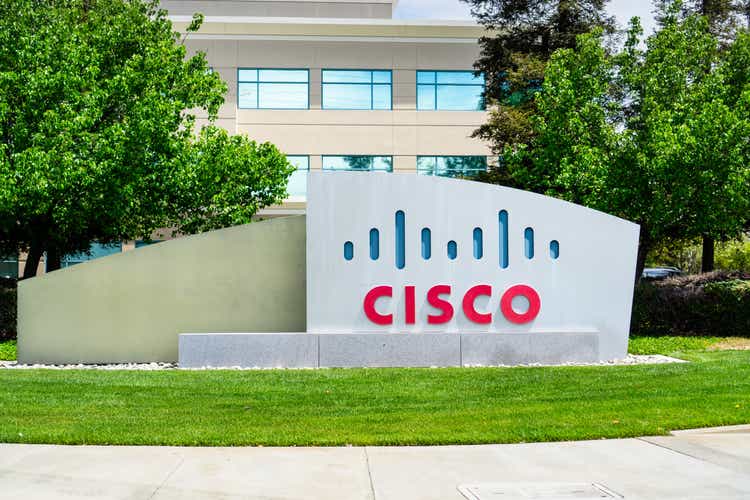 Sundry Photography Cisco (CSCO) has exhibited a modest 3.1% average revenue growth and 4.8% average adjusted operating profit growth over the past five years. The company is experiencing a decline in market share within both the networking and security end markets. Consequently, I recommend initiating coverage with a 'Sell' rating and assigning a fair value of $45. Networking is Losing to AristaIt is evident that Cisco is ceding market share to Arista, with Cisco experiencing low-single-digit growth, whereas Arista (ANET) has achieved double-digit growth over the past few years. The accompanying chart underscores this trend, revealing that Cisco added only 1 million 100/200/400G switch ports compared to Arista's notable 2 million during the same period. 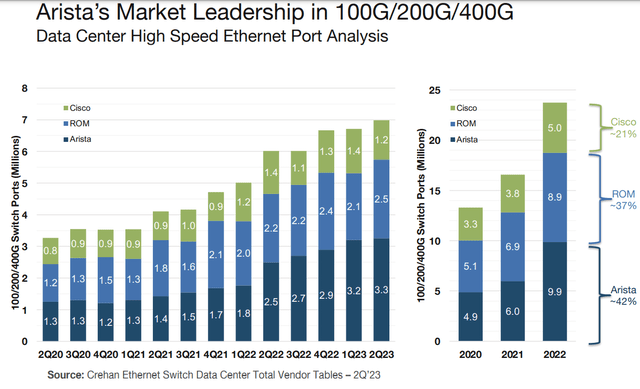
Arista Investor Deck The decline in Cisco's market share can be attributed to several factors. Firstly, a decade ago, as enterprises began migrating their workflows to the cloud, Cisco did not promptly adjust its product strategy to align with the demands of the cloud transition era. Instead, the company maintained its focus on traditional on-premise routers and switching technology, neglecting significant investments in software-defined networking (SDN). SDN-powered switches offer greater suitability for cloud deployment, providing enhanced flexibility and scalability capabilities. Secondly, a decade ago, Cisco held a dominant position, with traditional networking products generating substantial cash flow and profits. The challenge arose when it became difficult for the company to disrupt its own success and reallocate resources to embrace newly developed technologies. Lastly, in 2013, Cisco introduced ACI, its premier software-defined networking (SDN) solution for data centers, utilizing the Nexus 9000 series products as spine and leaf switches. While Cisco endeavors to catch up with rivals in providing data center solutions, the company finds itself arriving late to the game. Moreover, Cisco's historical premium pricing is losing favor among enterprises as more budget-friendly options emerge. Outdated Network SecurityCisco's End-to-End Security business encompasses Cloud and Application Security, Industrial Security, Network Security, and User and Device Security. A decade ago, Cisco's security business thrived as a bundled offering with their networking devices, providing a comprehensive solution for network integration. However, in the current era of cloud computing, their End-to-End Security has become outdated, lagging behind competitors such as Palo Alto (PANW). In FY23, Cisco's End-to-End Security revenue only experienced a modest growth of 4.3%. It appears that their security products remain hardware-centric, a characteristic ill-suited to the evolving demands of cloud security and comprehensive protection. In contrast, rivals like Palo Alto employ a modular approach, offering multiple modules or subscriptions to counter various internet threats. The accompanying chart illustrates the revenue trends among major cybersecurity companies, highlighting Palo Alto and Fortinet's (FTNT) significant market share gains in latest years. Their success can be attributed to software and module-centric products that align more effectively with the requirements of cloud infrastructure. 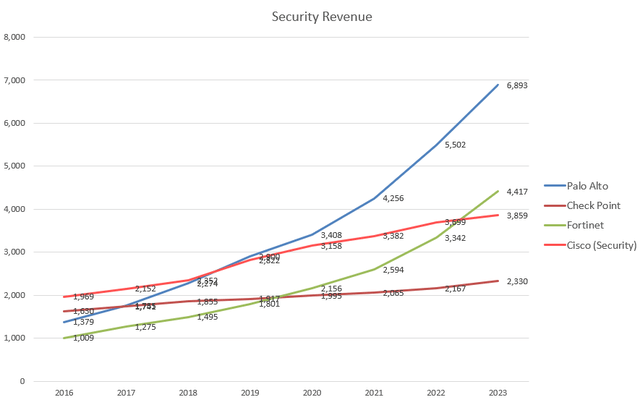
Palo Alto, Check Point, Fortinet, Cisco 10Ks For readers seeking a deeper understanding, I recommend referring to my introductory article on Palo Alto Networks. Splunk AcquisitionCisco is strategically leveraging M&A to transition a significant portion of their business towards software and services. Noteworthy acquisitions include Splunk, acquired for $28 billion in 2023, IMImobile for $730 million in 2021, ThousandEyes for $1 billion in 2020, and Duo Security for $2.3 billion in 2018. While the Splunk deal has the potential to enhance Cisco's capabilities in security and observability, it appears that there are limited synergies between Splunk and Cisco. The primary driver behind Cisco's decision to acquire at such a high cost is their struggle with topline growth. Cisco is paying a premium of approximately 30% over Splunk's market price before the deal was announced, with the acquisition price implying over 7x forward revenue. The accompanying chart illustrates Splunk's revenue growth and adjusted operating margin trend, which is currently standing at around the low-to-mid teens. 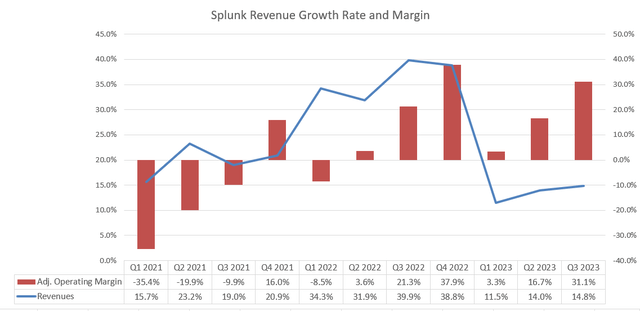
Splunk Quarterly Results Splunk specializes in security data analytics, operating a platform that collects extensive datasets from various sources. However, according to Palo Alto's management, Splunk's solutions may present challenges in promptly investigating cybersecurity incidents. Palo Alto's Security Operations Center (SOC), on the other hand, can seamlessly integrate AI into SOC transformation and automation processes, allowing for faster and more efficient investigation of cyber threats. It's worth noting that Splunk is actively investing in AI and automation technologies, and its vast datasets remain a key advantage in the cybersecurity space. In addition, Splunk is endeavoring to expand its presence in the infrastructure observability market. However, as a relatively smaller player in this space, it faces competition from established companies such as Datadog (DDOG) and Dynatrace (DT). It appears that Splunk, entering the field later, may struggle to compete effectively against these specialized players. According to Datadog's management, Splunk's platform is centralized in security management, presenting a notable difference from Datadog's infrastructure, which operates in real-time. For a more in-depth exploration of observability, I recommend referring to my introductory article on Datadog. In summary, the potential for synergies between Cisco and Splunk is questionable. This uncertainty arises from the fundamental differences in Splunk's business model, centered around subscription-based solutions, and Cisco's traditional hardware-centric business model. Isovalent DealCisco announced its acquisition of Isovalent in December. Cisco had previously participated in the startup's Series A funding at the end of 2020. Isovalent, a cloud-native security and networking startup, is expected to enhance Cisco's security capabilities for cloud infrastructure. Isovalent leverages eBPF and Cilium to gather data sets from both Linux and Windows, integrating with various platforms and applications such as Splunk, Datadog, and Isovalent itself. I believe the acquisition of Isovalent will benefit Splunk's ecosystem. It's important to note that Isovalent, while a small company, faces competition from several alternatives in the market. Financial Results and OutlookDuring Q1 FY24, Cisco achieved a robust 7.6% revenue growth and an impressive 27.6% growth in adjusted net income, reaching the upper end of their guidance range. 
Cisco Quarterly Results Their balance sheet remains strong with $23.5 billion in cash and cash equivalents. Operating activities generated $2.4 billion in cash, and they returned $2.8 billion to shareholders through dividends and share repurchases. For FY24, revenue guidance is set to be between $53.8 billion and $55 billion, with Non-GAAP earnings per share ranging from $3.87 to $3.93. The guidance suggests one or two quarters of low revenue growth followed by a return to normal growth. The subdued growth in the upcoming quarters is attributed to implementation constraints, with large customers working through elevated product shipments from previous quarters. Essentially, Cisco over-earned in the prior fiscal year. The current full-year guidance implies an approximately -5% revenue growth rate, a reasonable expectation given the over-earning in the preceding fiscal year. The table below provides an overview of Cisco's historical financials. In summary, they have demonstrated a low growth rate in both topline and bottom-line figures, with an average of 3.1% revenue growth and 4.8% net income growth. Their balance sheet remains robust with a net positive cash position, and their dividend payout and share buyback activities are deemed decent. 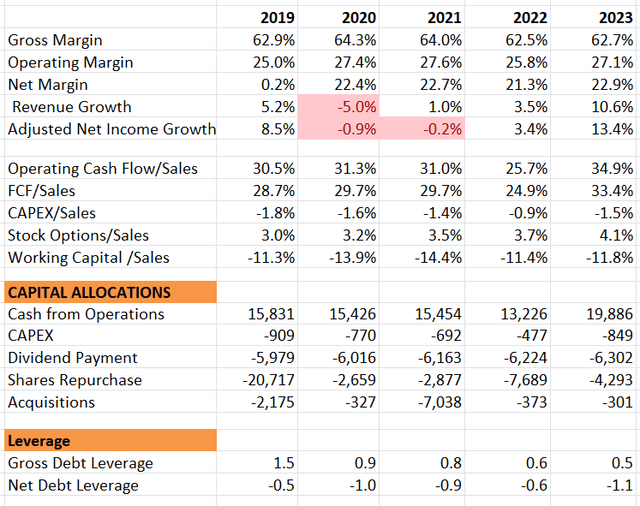
Cisco 10Ks ValuationThe revenue growth assumption for FY24 takes into account the near-term headwinds stemming from elevated inventory shipped to their large customers, aligning with their provided guidance. When projecting normalized revenue growth, the model assumes 3% for organic revenue growth and 0.7% for acquisition growth, consistent with their historical average. Given the sluggish top-line growth, the likelihood of generating significant operating leverage is low. The estimate suggests only a 10 basis points leverage annually. 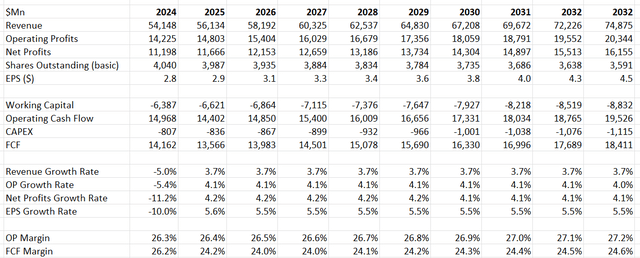
Cisco DCF - Author's Calculations The model employs a 10% discount rate, assumes a 3% terminal growth rate, and considers a 19% tax rate. Based on these parameters, the calculated fair value is $45 per share. Key RisksWeak Growth in Q2 and Q3 FY24: As discussed in their Q1 FY24 earnings call, the management anticipates a challenging Q2 and Q3, attributing it to the elevated inventory shipped to their large customers. I believe the subdued growth in the upcoming quarters is temporary, and their growth rate should resume once these customers have successfully digested their inventories. Collaboration Business Decline: The collaboration business, contributing over 7% to Cisco's total revenue, faced a decline of 9.4% in FY23 and 5.4% in FY22. Cisco encompasses Meetings, Collaboration Devices, and Contact Center businesses within this segment. The significant rise of Zoom (ZM) has introduced considerable downside risk for Cisco's collaboration business, and I anticipate ongoing pressure on this business segment in the future. ConclusionIn light of the challenges Cisco is facing in the cloud transition era and the perceived erosion of their competitive advantages, particularly in the realm of on-premise networking, I am initiating a 'Sell' rating. I assign a fair value of $45. 
Android Intelligence Google Assistant's forgotten memory magicYour Android device has a powerful system for helping you recall almost anything imaginable, but — oh, yes — it's up to you to remember to use it.
InvestorPlace - Stock Market News, Stock Advice & Trading Tips The Nasdaq 100 had a banner year. After a disastrous 2022 that saw the tech-laden index lose one-third of its value, it rebounded sharply in 2023 soaring 55% to hit a new all-time high. Of course, most of those gains were because of the performance of the Magnificent 7 stocks. Since the index is market cap-weighted the relative size of the companies skewed the results. Apple (NASDAQ:AAPL) alone accounts for 9% of the Nasdaq 100 while Microsoft (NASDAQ:MSFT) represents another 8.6%. Together, the seven companies total over 38% of the index. Goldman Sachs (NYSE:GS) called their performance the “defining feature of the equity market in 2023.” That means last year’s Nasdaq 100 performance wasn’t very broad-based. It will be difficult for that select group of stocks to repeat their gains this year. Instead, quite a few undervalued tech stocks in the index will soar in 2024. Here are the top seven to consider. Cisco (CSCO)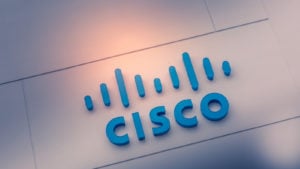
Source: Valeriya Zankovych / Shutterstock.com Cisco (NASDAQ:CSCO) used to be known as the “backbone of the internet” because of the role its routers and networking equipment played in keeping business online. Today the commoditization of hardware is a challenge. So are the rise of cloud computing and changing IT buying patterns. To address these issues, Cisco is evolving its software, cloud, and security strategy. It aims to transition the majority of its portfolio to everything-as-a-service over time. It calls the move Cisco+. The software-focused approach could create large gains for the company in the long run, as it makes its revenue less cyclical, more recurring, and more profitable. It just delivered its strongest fiscal first quarter in company history. Revenue jumped 8% to $14.7 billion while profits raced 36% higher to $3.6 billion. Cisco still needs to demonstrate its value proposition to its customers. By executing on its software, cloud, and security strategy, it can achieve its growth targets and retain its market leadership. With the stock trading at 12 times earnings estimates and 11x free cash flow (FCF), it’s presenting excellent value with tremendous upside potential. Gilead Sciences (GILD)
Source: Sundry Photography / Shutterstock.com Biopharmaceutical Gilead Sciences (NASDAQ:GILD) develops and commercializes antiviral therapies for treating HIV, hepatitis, and cancer. Biktarvy for HIV is its lead drug, generating $3.1 billion in sales globally in the third quarter and $8.7 billion year-to-date. That’s up 17% from last year. A second treatment, Descovey, has $1.3 billion in sales over the first three quarters of 2023. These drugs are offsetting the decline of older therapies like Veklury, which was the first FDA-approved antiviral for Covid-19. Although Gilead generated significant revenue from it in 2020 and 2021, sales are rapidly fading. There is a dual-edged sword to the potential of its cell therapies Yescarta and Tecartus. On the one hand sales of the treatments are up 35% this year, but on the other the FDA is investigating potential issues with such chimeric antigen receptor T-cell (CAR T-cell) therapies. Cancer patients treated with CAR T-cell drugs reportedly developed lymphomas or other malignancies. Gilead operates a new automated CAR T-cell facility that just got FDA approval in April 2022. Fortunately, the therapies aren’t critical to Gilead’s current performance so far, but they are a future growth channel that could be at risk. The biotech does have a healthy pipeline of treatments in clinical trials. So long as it can successfully launch and grow its new products, especially in the oncology and inflammatory segments, and leverage its existing portfolio and pipeline to diversify and strengthen its revenue streams, it got potential to rocket higher this year. Axcelis Technologies (ACLS)
Source: Pavel Kapysh / Shutterstock.com Axcelis Technologies (NASDAQ:ACLS) doesn’t make chips itself but makes ion implantation systems that are critical to the chip-making process. It’s part of a duopoly with Applied Materials (NASDAQ:AMAT) offering a full range of implant products. Their international competitors don’t have the same breadth of products and services. The booming semiconductor industry means there is more than enough business to go around. Axcelis sales jumped 25% so far this year with profits racing 39% higher. While the stock soared 63% in 2023 there’s good reason to believe it can continue climbing. Due to the heightened demand for electric vehicles (EV), renewable energy, and 5G applications, Axcelis can rapidly expand its share in the silicon carbide power market. It’s the only company with a product line that can deliver complete recipe coverage for all power device applications. It also has a diversified customer base, including those for so-called trailing-edge processes. These are older and less advanced technologies still widely used for automotive, industrial, and Internet of Things applications but still have robust demand. Axcelis’ Purion line can support a wide range of implant applications, from 300mm to 200mm and smaller wafers. Despite its stock gains Axcelis still trades at 15 times earnings estimates and a fraction of its long-term earnings growth rate. There’s no reason it can’t rocket even higher next year. Fortinet (FTNT)
Source: Sundry Photography / Shutterstock.com Cybersecurity specialist Fortinet (NASDAQ:FTNT) is benefiting from the inexorable transition of data to the cloud. It provides cybersecurity solutions for enterprises, service providers, and government organizations. The number of security breaches hit record levels before the year even ended. Although the cybersecurity arena is becoming more competitive, Fortinet has several levers it can pull to dramatically increase growth. The artificial intelligence (AI)-based cybersecurity market is expected to grow rapidly because of the increasing sophistication and frequency of cyberattacks. Fortinet invested heavily in AI and machine learning capabilities to enhance its threat detection, prevention, and response solutions. There had been a concern enterprise customers would cut back on cybersecurity spending if a recession loomed, but the damage to operations and reputation might prevent that from happening on too broad of a scale. Fortinet can also leverage its Security Fabric platform, which integrates and automates security from network to cloud to endpoint. It says the platform enables customers to achieve higher levels of security, performance, and efficiency, while reducing complexity and costs. It’s also establishing itself as the industry leader in firewalls and software-defined wide area networks, or SD-WANs. It’s an emerging computer networking technology that connects data centers to branches and the cloud. Fortinet’s stock isn’t cheap, but it still has the chance to expand its multiples even more in the year ahead. Intel (INTC)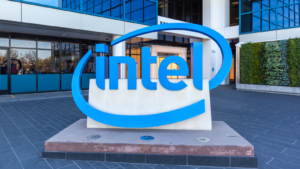
Source: JHVEPhoto / Shutterstock.com Chip maker Intel (NASDAQ:INTC) had an impressive run in 2023 but should still be considered an undervalued tech stock. It is working to regain its technical edge over Advanced Micro Devices (NASDAQ:AMD) and Taiwan Semiconductor Manufacturing (NYSE:TSM). New products including Emerald Rapids Xeon processors and Meteor Lake mobile processors aim to restore Intel’s superiority or at least gain technical parity. Similarly its new Gaudi3 AI chip puts Intel in the game with Nvidia (NASDAQ:NVDA) and AMD. Intel is also leveraging its chip manufacturing capabilities in the foundry business to provide chip fabrication services to other companies. It counts Amazon (NASDAQ:AMZN) and the U.S. Defense Dept. as clients. The fact that it is primarily based in the U.S. gives it a competitive edge in the wake of global geopolitical uncertainty that’s disrupted supply chains worldwide. It also has a new fab facility in Europe to expand its capacity and meet growing chip demand there. Intel’s data center business faced challenges in latest years due to increased competition, innovation, and market shifts. However, that is expected to recover. Similarly, the expected debut in 2024 of AI PCs could revive the industry. These are just some of the growth levers available to Intel to pull in 2024. Expedia (EXPE)
Source: NYC Russ / Shutterstock.com Online travel stock Expedia (NASDAQ:EXPE) took a long trip higher in 2023. Shares rose 80% with most of the gains beginning in November on travel demand returning to pre-pandemic levels. Expedia beat analyst profit estimates and recorded record revenue in the third quarter. According to the International Air Transport Association, overall traveler numbers will exceed pre-Covid levels. They are expected to reach 4 billion in 2024. Passenger volume is projected to hit 9.4 billion passengers worldwide this year, surpassing 2019’s 9.2 billion. Expedia remains one of the leading online travel companies with well-known brands including its namesake Expedia.com, Hotels.com, Vrbo, and Egencia. Despite last year’s gains the online travel agency trades at a lower valuation than its peers and its own historical averages. The stock goes for just 12 earnings estimates and 11 times free cash flow. Profit margins and cash flow generation, however, are stronger than some rivals like Trip.com (NASDAQ:TCOM) and Airbnb (NASDAQ:ABNB). Moreover, Expedia can use platforms like Vrbo to further encroach on territory already held by Airbnb. Look for Expedia to continue rebounding in 2024 as the travel industry recovers from the pandemic and adapts to the new normal. Netflix (NFLX)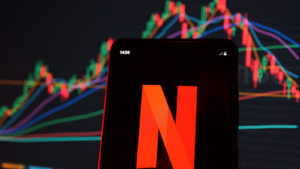
Source: TY Lim / Shutterstock.com To paraphrase Mark Twain, the rumor of Netflix (NASDAQ:NFLX) death has been greatly exaggerated. In fact, Netflix actually won the streaming wars. While competing services like Disney‘s (NYSE:DIS) Disney+ and Paramount Global‘s (NASDAQ:PARA) Paramount+ burst on the scene during the pandemic with great fanfare, they haven’t been able to maintain their momentum. Analysts believed movie studios getting into streaming would undercut Netflix ability to survive. Pulling content from the platform for their own streaming services would starve Netflix of content. As it turns out, there really hasn’t been enough of a reason to continue subscribing to these rivals while Netflix is still expanding. It ended the third quarter with 247 million subscribers worldwide. Although it was believed Netflix cracking down on password sharing could damage its business, that’s not the case either. It has an opportunity to grow even more by converting an estimated 100 million users into paying customers. Advertising is another huge opportunity, though CFO Spencer Neumann told Bank of America (NYSE:BAC) says Netflix is still “the crawl of the crawl-walk-run stage” of both growth levers. Netflix has also shown it possesses superb pricing power. It avoided increasing customer churn by responsibly increasing subscription costs. This is a trio of opportunities the streamer can continue to press to its advantage this year. It’s stock is not the cheapest either, but having survived the streaming wars and come out on top again indicates Netflix is an undervalued tech stock that can keep growing in the year ahead. On the date of publication, Rich Duprey did not hold (either directly or indirectly) any positions in the securities mentioned in this article. The opinions expressed in this article are those of the writer, subject to the InvestorPlace.com Publishing Guidelines. More From InvestorPlaceThe post Nasdaq 100 Alert: 7 Undervalued Tech Stocks Ready to Rocket in 2024 appeared first on InvestorPlace. | ||||||||
300-535 exam plan | 300-535 Study Guide | 300-535 teaching | 300-535 basics | 300-535 study | 300-535 certification | 300-535 test prep | 300-535 exam success | 300-535 student | 300-535 study help | | ||||||||
Killexams exam Simulator Killexams Questions and Answers Killexams Exams List Search Exams |
300-535 Reviews by Customers
Customer Reviews help to evaluate the exam performance in real test. Here all the reviews, reputation, success stories and ripoff reports provided.
100% Valid and Up to Date 300-535 Exam Questions
We hereby announce with the collaboration of world's leader in Certification Exam Dumps and Real Exam Questions with Practice Tests that, we offer Real Exam Questions of thousands of Certification Exams Free PDF with up to date VCE exam simulator Software.







